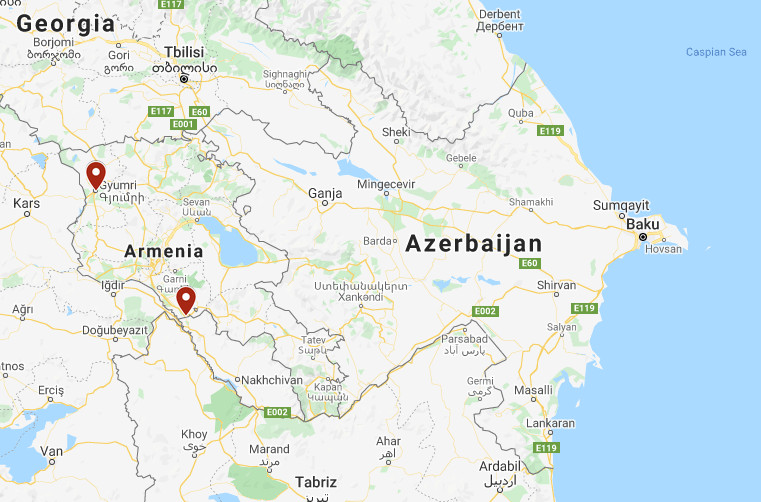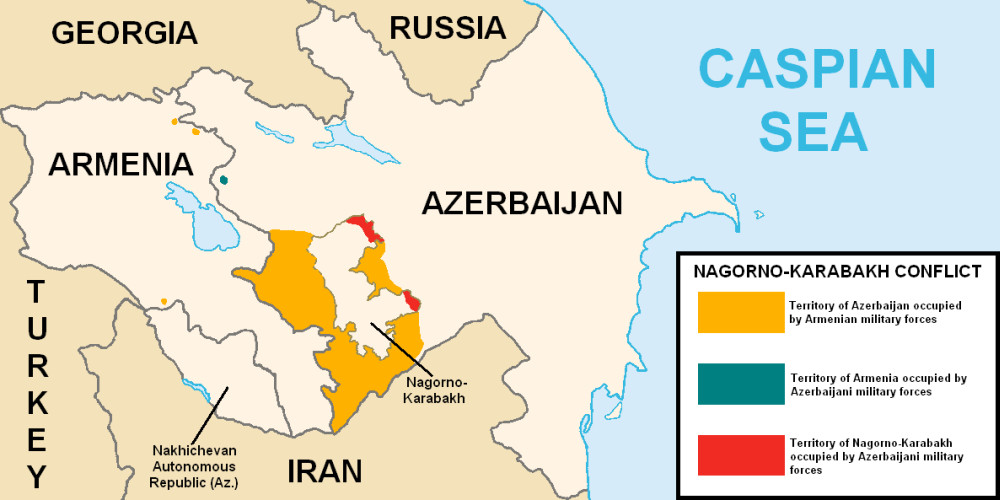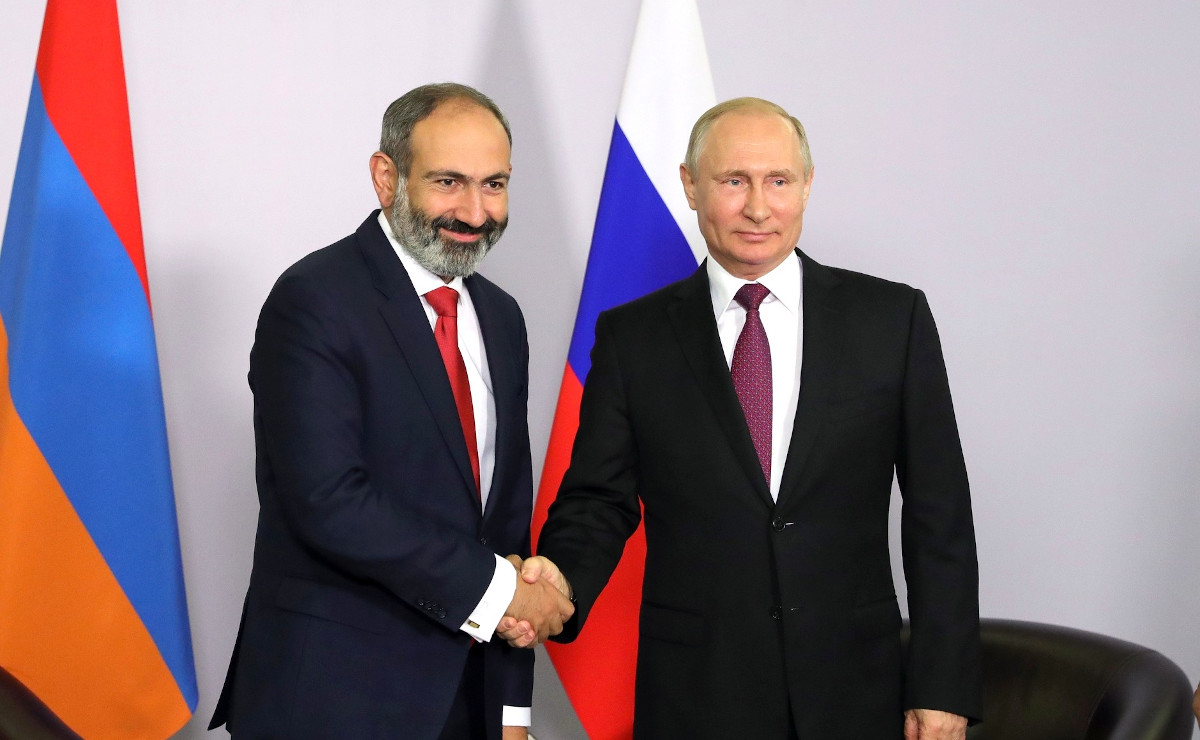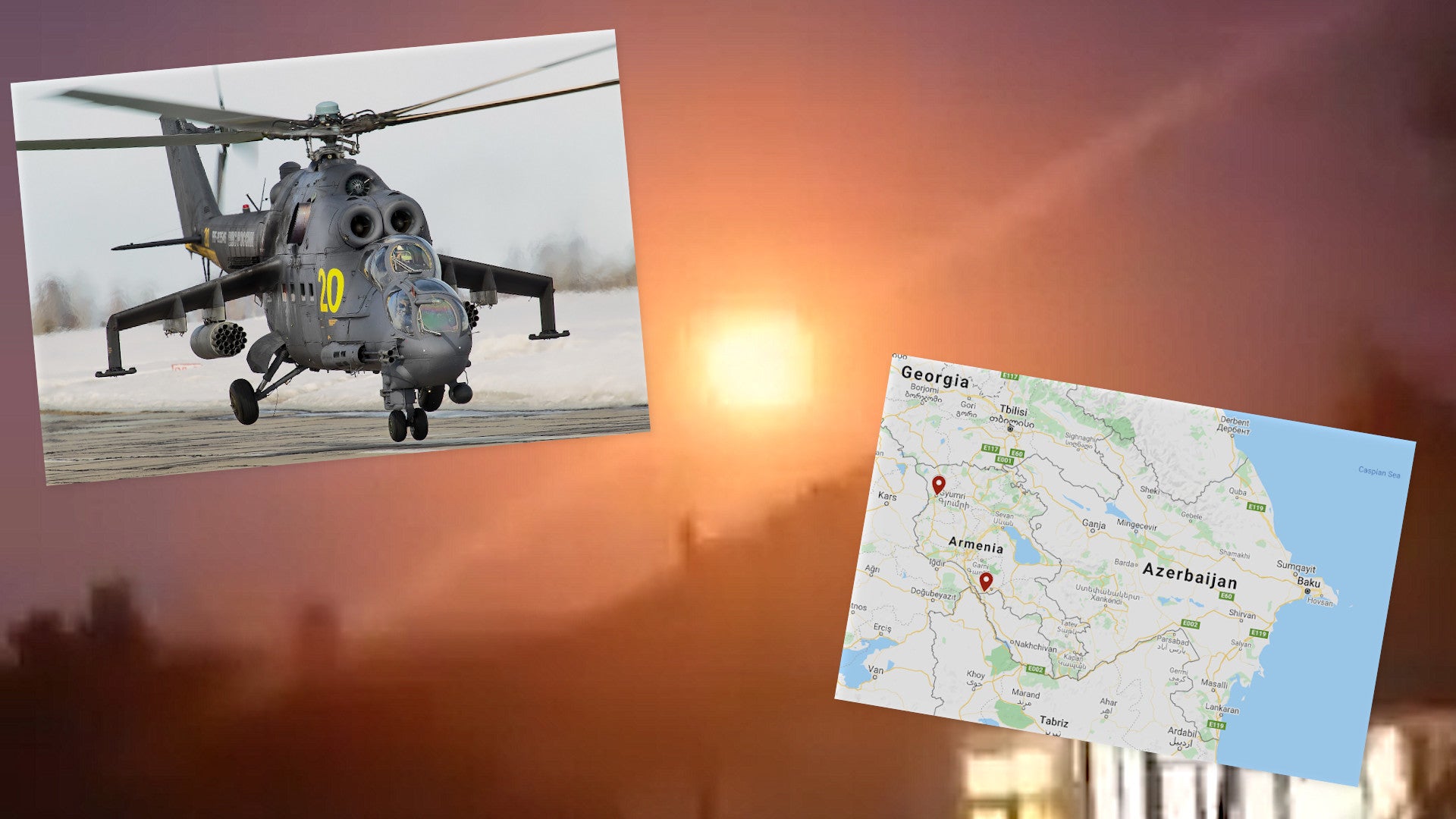Details are still limited, but the Russian Ministry of Defense says that one of its Mi-24 Hind gunship helicopters has been shot down over Armenia while operating close to the country’s western border with Azerbaijan’s geographically separated Nakhchivan Autonomous Republic. The Kremlin has not yet said who it believes to be responsible. Armenian forces have been fighting an increasingly grueling conflict with Azerbaijan over the disputed Nagorno-Karabakh region since the end of September.
Video purporting to show the moment a missile hit the Mi-24, as well as images from the crash site, first began to emerge on social media on Nov. 9, 2020. The Russian Ministry of Defense subsequently confirmed the shootdown, which it said was the result of a shoulder-fired man-portable surface-to-air missile system (MANPADS), adding that two individuals on board had died in the incident. A third person was seriously injured and medically evacuated from the crash site. The helicopter had been providing an aerial escort for a convoy of Russian troops from the country’s base in Armenia, known as the 102nd Russian Military Base in the city of Gyumri in northwestern Armenia.

“On November 9, at about 17:30 Moscow time, a Russian Mi-24 helicopter came under fire from the ground from a man-portable air-defense system when accompanying a vehicle convoy of the 102nd Russian military base on the territory of the Republic of Armenia in the airspace close to the Armenian settlement of Yeraskh near the border with the Nakhchivan Autonomous Republic (the Republic of Azerbaijan),” the Russian Defense Ministry’s statement said.


It’s not clear how many people were riding in the helicopter when it came down. The Hind is a unique design with its crew of two seated one behind the other at the front, as is the case with most gunships, but with a small passenger compartment also in the center of the fuselage.

The current fighting between Armenia and Azerbaijan broke out on Sept. 27, with Azerbaijani forces moving into the disputed Nagorno-Karabakh region. The two countries, both former Soviet republics, have been fighting over the region since before the collapse of the Soviet Union. A ceasefire agreement brought an end to that initial fighting in 1994, with the self-declared, Armenian-backed Republic of Artsakh being the de facto authority in the territory ever since. There have been multiple significant skirmishes between the two sides since then.
While the Kremlin has yet to publicly blame anyone for the shootdown and no party in the region has taken responsibility, there is already growing speculation that Azerbaijani forces in Nakhchivan may have been responsible. The incident appears to have taken place at night and Armenia also operates Mi-24s, raising the distinct possibility that troops in the Azerbaijani autonomous region may have believed the helicopter to have been Armenian. Yeraskh is less than five miles from the Armenian border with Nakhchivan.
Since the latest conflict over Nagoro-Karabakh first erupted in September, there have been concerns about a potential Russian intervention into the fighting. Armenia is notably a member of the Collective Security Treaty Organization (CSTO) bloc, as is Russia, which includes collective security provisions.
The Kremlin had previously said that it would not intervene unless Armenia proper came under attack. Azerbaijan has launched artillery and ballistic missile strikes into Armenian territory since then. Armenian Prime Minister Nikol Pashinyan formally asked Russian President Vladimir Putin for unspecified security assistance on Oct. 31, but it’s unclear what support Russia may have provided since then. There were already unconfirmed reports before then that Russian personnel in the country had been assisting the Armenians, including with electronic warfare systems to counter Azerbaijan’s distinct advantage in armed drones and loitering munitions, also called “suicide drones,” which have been a major factor in the fighting so far.

For its part, Azerbaijan has been receiving significant support from Turkey, which publicly supports its current campaign to recapture Nagorno-Karabakh. A contingent of Turkish Air Force F-16 Vipers have also notably been in that country since July, though it remains unclear if they have taken a direct part in the conflict. Turkey has also facilitated the transport of Syrian militants to the region to fight on behalf of the government in Baku. There are other unconfirmed claims that Turkish special operations forces may be on the ground assisting Azerbaijani forces.
If Russia determines Azerbaijani forces were responsible for the shootdown and that the incident was not a case of mistaken identity or some other kind of accident, it could well change the Kremlin’s position on its role in the conflict. This, in turn, would increase the risks of further escalation, especially if Turkey were to become more directly involved.
In the meantime, the fighting between Armenia and Azerbaijan shows no signs of letting up despite international calls for the two sides to seek a non-violent resolution to the crisis. There have been three failed ceasefire attempts already, each of which has collapsed within 24 hours of the agreed start time.
Whatever happens next, the shootdown of the Russian Mi-24 is a dangerous new development in the conflict and underscores the continued risk of it becoming a broader, regional affair.
We will continue to update this story as more information becomes available.
UPDATE: 1:55pm EST
The Azerbaijni Foreign Ministry has now confirmed that its forces shot down the Russian Mi-24 with a MANPADS, but also say that it was case of mistaken identity.
“The helicopter was flying in the close vicinity of the Armenian-Azerbaijani state border at the time of active hostilities in the zone of the Armenian-Azerbaijani Nagorno-Karabakh conflict. The flight was taking place after dark, at a low altitude, outside the air defense radar detection zone. Helicopters of the Russian Armed Forces had not been detected in said area previously,” Azerbaijan’s Foreign Ministry said in a statement. “In the context of the aforementioned factors and in the light of the tense situation in the region and the high military alert due to possible provocations of the Armenian side, the on-duty operational crew made the decision to use deadly force.”
“The Azerbaijani side apologizes to the Russian side over this tragic incident, which was of an accidental nature and was not aimed against the Russian side,” the statement continued. “The Azerbaijani side sends its deepest condolences to the families of the crew members killed in the incident and wishes the soonest recovery to those injured. The Azerbaijani side is ready to pay the corresponding damages.”
Contact the author: joe@thedrive.com
